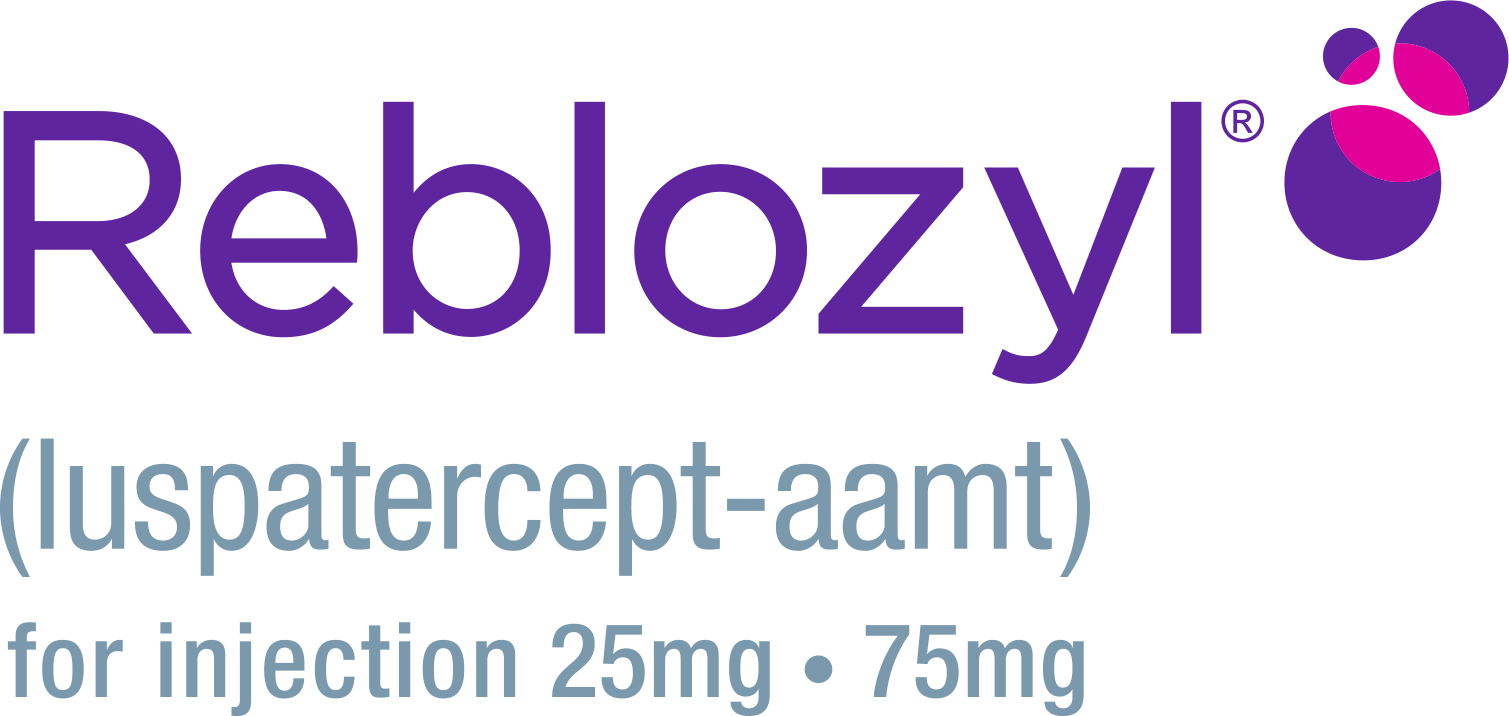Luspatercept-aamt (REBLOZYL®) is a preferred, first-line treatment option for symptomatic anemia in RS- and RS+ LR-MDS as recommended by the NCCN Clinical Practice Guidelines in Oncology (NCCN Guidelines®)1*
REBLOZYL FOR FIRST-LINE TREATMENT OF ANEMIA DUE TO LR-MDS

Based on a head-to-head study vs epoetin alfa‡
REBLOZYL raises the standard of care in 1L LR-MDS–associated anemia2,3
ESA Limitations4
Most 1L patients with LR-MDS will fail on an ESA.4Importance of Hgb5
Increasing Hgb to ≥10 g/dL impacts quality of life.5Superior Efficacy2
REBLOZYL provides superior Hgb improvement and RBC-TI vs epoetin alfa.2Dosing Guidance2
Dose escalate to achieve or regain a response.2*For patients with IPSS-R very low-, low-, or intermediate-risk MDS with non-del(5q) ± other cytogenetic abnormalities and with RS <15% (or RS <5% with SF3B1 mutation) with sEPO ≤500 mU/mL or with non-del(5q) ± other cytogenetic abnormalities with RS ≥15% (or RS ≥5% with an SF3B1 mutation).1
†In patients with sEPO levels <500 U/L.2
‡>90% of study participants were outside of the United States and used a non-US-licensed epoetin alfa product. Direct comparisons between REBLOZYL and US-licensed epoetin alfa product have not been established.2
STUDY DESIGN2,3
COMMANDS (N=356) was a Phase 3, randomized, open-label, active-controlled trial comparing REBLOZYL vs epoetin alfa in adult patients with anemia due to IPSS-R very low-, low-, or intermediate-risk MDS, with or without ring sideroblasts, who were ESA-naive (with endogenous sEPO levels <500 U/L) and required RBCT. Patients with del(5q) and those previously treated with disease-modifying agents or HMAs were excluded.
Patients were randomized to either REBLOZYL (n=178) 1 mg/kg SC Q3W, with titration up to max 1.75 mg/kg if needed to achieve response, or epoetin alfa (n=178) 450 IU/kg SC QW max total dose 40K IU, with titration up to 1050 IU/kg max total dose 80K IU. The primary endpoint was RBC-TI with a mean improvement in Hgb by at least 1.5 g/dL for any consecutive 12-week period during Weeks 1 to 24.
EFFICACY RESULTS2,3,6,7
Primary endpoint (RBC-TI for ≥12 weeks with concurrent mean Hgb increase ≥1.5 g/dL): 58.5% (n=86/147; 95% CI: 50.1, 66.6) of patients in the REBLOZYL treatment group and 31.2% (n=48/154; 95% CI: 24.0, 39.1) of patients in the epoetin alfa treatment group achieved RBC-TI with Hgb increase during Weeks 1 to 24.
Key secondary endpoints included HI-E per IWG ≥8 weeks (Weeks 1-24): REBLOZYL 74.1% (n=109/147), epoetin alfa 51.3% (n=79/154); RBC-TI for 24 weeks (Weeks 1-24): REBLOZYL 47.6% (n=70/147), epoetin alfa 29.2% (n=45/154); and RBC-TI for ≥12 weeks (Weeks 1-24): REBLOZYL 66.7% (n=98/147), epoetin alfa 46.1% (n=71/154). Other secondary endpoints included median duration (weeks) of RBC-TI ≥12 weeks (Week 1 to EOT): REBLOZYL 126.6 weeks (95% CI: 108.3, NR), epoetin alfa 77.0 weeks (95% CI: 39.0, NR). Both treatments were dose modified targeting Hgb between 10-12 g/dL and Tl.
1L=first-line; CI=confidence interval; EOT=end of treatment; EPO=erythropoietin; ESA=erythropoiesis-stimulating agent; Hgb=hemoglobin; HI-E=hematologic improvement-erythroid; HMA=hypomethylating agent; IPSS-R=Revised International Prognostic Scoring System; IWG=International Working Group; LR-MDS=lower-risk myelodysplastic syndromes; MDS=myelodysplastic syndromes; NCCN=National Comprehensive Cancer Network; NR=not reached; QW=once a week; Q3W=once every 3 weeks; RBCT=red blood cell transfusion; RBC-TI=red blood cell transfusion independence; RS=ring sideroblast; SC=subcutaneous; sEPO=serum erythropoietin; TI=transfusion independence.
References: 1. Referenced with permission from the NCCN Clinical Practice Guidelines in Oncology (NCCN Guidelines®) for Myelodysplastic Syndromes V.1.2025. © National Comprehensive Cancer Network, Inc. 2024. All rights reserved. Accessed November 18, 2024. To view the most recent and complete version of the guideline, go online to NCCN.org. NCCN makes no warranties of any kind whatsoever regarding their content, use or application and disclaims any responsibility for their application or use in any way. 2. REBLOZYL [US Prescribing Information]. Summit, NJ: Celgene Corporation; 2024. 3. Platzbecker U, Della Porta MG, Santini V, et el. Efficacy and safety of luspatercept versus epoetin alfa in erythropoiesis-stimulating agent-naive, transfusion-dependent, lower-risk myelodysplastic syndromes (COMMANDS): interim analysis of a phase 3, open-label, randomised controlled trial. Lancet. 2023;402(10399):373-385. 4. Fonseca G, Warner A, Ming A, et al. Management of patients with lower-risk myelodysplastic syndromes in a large US community oncology practice: a focus on patient outcomes post erythropoiesis-stimulating agent treatment. Presented at: Society of Hematologic Oncology (SOHO) Annual Meeting. September 4-7, 2024. Houston, TX, USA. 5. Oliva E, Yucel A, Lord-Bessen J, et al. Relationship between haemoglobin and quality of life in transfusion-dependent patients with lower-risk myelodysplastic syndrome receiving luspatercept or epoetin alfa. Presented at: European Hematology Association (EHA) Hybrid Congress. June 13-16, 2024. Madrid, Spain. Abstract P774. Abstract available at EHA library. 6. Platzbecker U, Della Porta MG, Santini V, et el. Efficacy and safety of luspatercept versus epoetin alfa in erythropoiesis-stimulating agent-naive, transfusion-dependent, lower-risk myelodysplastic syndromes (COMMANDS): interim analysis of a phase 3, open-label, randomised controlled trial (supplementary appendix). Lancet. 2023; published online June 10, 2023. https://doi.org/10.1016/S0140-6736(23)00874-7 7. Data on file. BMS-REF-00730-2007. Princeton, NJ: Bristol-Myers Squibb Company; 2024.

